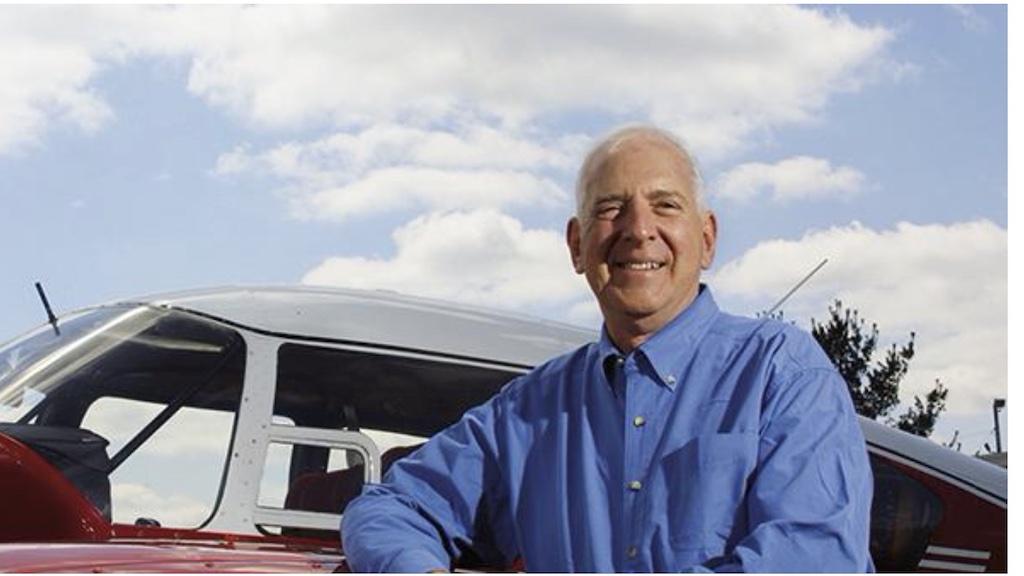
With Hal Shevers's ninth decade approaching, Sporty's hails its 'visionary leader,' whose flight plan for life has been as generous as it is successful.
The year was 1961, a time when anything seemed possible technologically. The U.S., along with the Soviet Union, launched men—astronauts—into space. IBM delivered its first transistorized supercomputer. Disney telecast its Mickey Mouse Club program in color. The X-15 rocketplane hit 4,093 mph, a record Mach 6. And Lockheed delivered its four-engine JetStar, launching the business jet era.
By then, transistor radios were ubiquitous. But one in particular—a hand-held Realtone Voyager—had become the indispensable accessory of one young flight instructor since it delivered control tower transmissions and real-time weather. He was so taken with the thing that he bought extras to sell to his students. The device proved so popular among students and fellow pilots that he bought even more, warehousing them in his apartment bedroom and the trunk of his Studebaker.
And thus was born Sporty’s Pilot Shop, which Hal Shevers, that tech-smitten CFI, would grow to become a general aviation superstore.
While he was a Purdue engineering student, Shevers joined the school’s aero club, where he began accumulating licenses and ratings, eventually becoming a part-time instructor. After graduating, he became a sales trainee at Cincinnati Milling Machine Co. Alas, he and the company soon parted ways, since by then, he had confirmed that flying and making pilots brought him greater satisfaction than the sale of industrial tools.
That realization was fortuitous, since the CFI proved to be as much a product-savvy purveyor as aviation educator. The prized radio with which he keyed his career redirection was soon joined by other aviator must-haves for the flight bag, flight deck, flight line or flight planning space. The offerings would keep expanding until eventually exceeding 1,000 products—ranging from headsets and tablets to smart watches and puffer vests and made available by phone, mail, online or in person.
Within Sporty’s first two years, it transferred the gear, texts, charts and more that were once consigned to Shevers’ car and apartment to a storefront at Cincinnati’s Lunken Airport (KLUK), where he had conducted flight training. The enterprise would eventually outgrow those facilities and move to Clermont County Airport in nearby Batavia, acquiring the fixed-based operator and assuming KI69’s management in the process.
Pilot training material was a key offering from Sporty’s very start. Some of those texts and videos complemented the traveling weekend ground school program that Shevers created in partnership with the Aircraft Owners and Pilots Association (AOPA). I was once among umpteen-thousands of aspiring aviators in attendance. Shevers and team went on to launch a Part 141 flight school at Clermont, aka “Sporty’s Airport,” which trains hundreds annually and partners with the University of Cincinnati on a professional pilot degree program.
Long an advocate of introducing youths to aviation’s magic, Shevers in 2000 oversaw the creation of Sporty’s Foundation with that clear focus. One of its first programs was to partner with the Experimental Aircraft Association’s (EAA) Young Eagles to offer free access to Sporty’s Learn to Fly course. Since then, the foundation has donated millions to a variety of aviation causes.
In 2009, Shevers sold Sporty’s to long-time employees and even lent them the funds to complete the acquisition. Thereafter, the founder assumed the role of “chairman without responsibilities.”
Shevers once shared with me his simple but profound life philosophy: “You learn, earn and return.” In other words, work to gain knowledge formally and practically, then apply that intelligence to making a living and earning respect—then finally sharing your wealth of wisdom, talent and capital with others in need of the same.
With its founder’s ninth decade approaching, Sporty’s announced in January that Shevers—its “visionary leader” and long its “driving force”—had retired, leaving “an indelible mark on the industry.” Sandy Shevers, Hal’s wife and a 50-year employee, also retired. That notice elicited salutes and well-wishes from Jack Pelton and Mark Baker, heads of EAA and AOPA, respectively, among the many admirers of an aviator whose life’s flight plan was fabulously successful and generous.
And salutes, too, for those individuals honored at the Living Legends of Aviation ceremony in Los Angeles on Jan. 19, including Gulfstream’s Mark Burns, CAE’s Marc Parent, Linden Blue of General Atomics, insurance broker Lance Toland and a former Apache combat pilot, the UK’s Prince Harry. I was especially pleased that among the new inductees was Fred George, my longtime BCA colleague and senior editor, since retired. Fred’s expertise in hardware evaluation and exposition is unique and well deserving of formal recognition. Congratulations to all.




